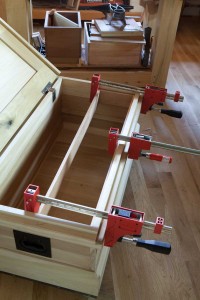We may receive a commission when you use our affiliate links. However, this does not impact our recommendations.
When you write for a woodworking magazine, there are several pat phrases that you use all the time. Such as:
1. Joint and plane all your stock flat and square. Cut all the pieces to the sizes shown in the cutting list.
2. Cut the tenons to match your mortises. (Or your mortises to match your tenons.)
3. After applying clamps, check the assembly to ensure it is square.
4. Clamp the assembly until the glue is dry.
5. Sand or plane all the surfaces to prepare them for finish.
6. Finish the project with your favorite stain and film finish.
All of these steps are hugely important, yet we often dispense with them in a couple phrases. Today, let’s talk about square carcases. They are a great thing, when they actually are dead square. Too often, something gets messed up during assembly and your carcase is rarely comprised entirely of 90° joints.
So then what do you do?
I was taught that usually you do … nothing. If you can’t see that the assembly is cockeyed with your naked eye, then it is not cockeyed. That philosophy works just fine until you have to put doors or drawers into the catawumpus assembly.
Then what?
Usually with doors you build them square and oversized – then trim them with a plane to fit the parallelogram of a carcase you made. With drawers, I don’t follow that philosophy. I’ll build them out of square to match the out-of-square carcase. Like I did today.
I’m building a travel-size version of “The Anarchist’s Tool Chest” so that I can take it to shows and schools and the like. I built this chest while I was teaching a class, and somehow I forgot to square up the case after gluing it together. It’s out of square about 1/16” over its 18” depth. You can’t see the out-of-squareness, but the chest’s sliding tills won’t slide if they are square.
If I built the tills square and then trimmed them down, that would be a ton of work and material and planing. And it probably will look like poo.
So the logical solution is to build them out of square. But how do you ensure they are as out-of-square as the carcase? Use the carcase as a clamping jig. As shown above, I’ve clamped a glued-up till between its runners to pull it into the same parallelogram as the chest.
There are some other tricks involved (such as undercutting the tails to ensure the joints pull up tight), but this is the better approach – for me , at least. So next time, consider building wacky drawers for a wacky carcase.
— Christopher Schwarz
Here are some supplies and tools we find essential in our everyday work around the shop. We may receive a commission from sales referred by our links; however, we have carefully selected these products for their usefulness and quality.









Chris –
As a hobbyist, allow me to say how much I appreciate an article like this. For me, “truly square” continues to remain an elusive dream, no matter how carefully I approach it in my projects (and I’m talking about 1/8″ and 1/4″ problems, not 1/128″). I have so often been frustrated when I get to the part of the article that reads, “check for square,” because it never (in my limited experience) tells me what to do when I find out it’s NOT square – the instructions just assume my world is comfortably 90 degrees all the way around and proceeds to the next step, while I whimper on the sidelines and say, “Well, NOW what??” I realize that sometimes you just have to go back to square one (no pun intended). But if the author of an article on constructing a project ever gets to the “check for square” point and has a few pointers to share with the reader in case the reader’s project is NOT square, then I would be eternally grateful if Megan would allow him/her a few extra sentences to share those pointers. It helps me believe that the professional author is thinking about us hobbyists every once in a while. And that’s really encouraging.
Love the mag. Love your work. Thanks for the blog post.
Chris, where did you get those nice cranked hinges from? Somewhere in the UK would be nice.
John
Will you be sharing the design and dimensions of this travel-size version of “The Anarchist’s Tool Chest”?
Chris –
That would work for a parallelogram, but what about a trapezoid? Do you plane the inside of the carcass until it is square?
Jonathan
============================================
You forgot a few of my favorites: You can never have too many clamps; I did this on my Powermatic, but you can easily get by with a handsaw; and this method works for me because…
Did you realize this before or after your blog post of yesterday? Maybe that title was less rhetorical and more literal.